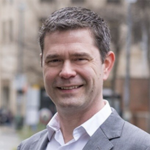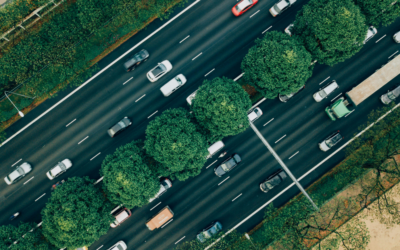Ask the Experts: Pedestrian Safety
In our latest episode of “Ask the Experts,” we sat down with Brian Chandler, PE, PTOE, RSP2IB, PMP, National Director for Transportation Safety at DKS Associates, to discuss safe streets, data, and the role technology can play in improving safety for everyone on the roads.
Quick facts:
- In 2020, 6,516 pedestrians were killed in the United States – an average of 18 pedestrians a day. In 2021, pedestrian fatalities were projected to be up 13% from 2020.
- National Pedestrian Safety Month recognizes how pedestrians and drivers can watch out for one another to keep our roads safe and celebrates the right of everyone to walk or roll safely.
- National Pedestrian Safety Month is a time to remind drivers of their responsibility to stay alert for pedestrians, cyclists, and other vulnerable road users.
Meet the Expert
 Brian Chandler is a Professional Engineer (PE), Professional Traffic Operations Engineer (PTOE), road safety professional Level 2, and Infrastructure and Behavioral (RSP2IB). He has over 20+ years of transportation experience in State government, Federal government, and consulting. He is the national expert in crash data analysis, engineering countermeasures, safety project evaluation, and safety management for DKS Associates, devoted to reducing roadway fatalities to zero.
Brian Chandler is a Professional Engineer (PE), Professional Traffic Operations Engineer (PTOE), road safety professional Level 2, and Infrastructure and Behavioral (RSP2IB). He has over 20+ years of transportation experience in State government, Federal government, and consulting. He is the national expert in crash data analysis, engineering countermeasures, safety project evaluation, and safety management for DKS Associates, devoted to reducing roadway fatalities to zero.
Ask the Experts
Q: Why is having a national pedestrian safety month important?
Brian Chandler: Any kind of recognition like this is just trying to bring an important topic to our minds. Even though we, particularly in the last decade or so, have very much encouraged pedestrians and cyclists to use the roads and travel in different ways, we still haven’t built the system for them. They are walking on roads that aren’t designed for their safety. That, unfortunately, has resulted in people getting hurt and killed in crashes as pedestrians because of their vulnerability.
Q: What role can data and technology play to improve road safety for everyone?
Brian Chandler: We don’t know where people are going to get hurt and killed in the future but we do know the types of roads on which they are more likely to be hurt and killed.
We can use vehicle volumes to help identify what safety risks might be, and lots of other layers including a lot of the work that you guys do at Urbanlogiq to bring in census data and other layers of demographic data as well.
The combination of that data with some of the traditional ways that we’ve looked at crash and safety risk I think is really the key. Using big data sets and definitely experimenting on the ways that we can do better at identifying safety risks by using new technology, new data sets, and new tools to try and look at that data.
There’s connected vehicle data now that allows us to see where people are having rapid deceleration so that might be a precursor to rear-end crashes, where people are doing rapid lane changes on a freeway that might relate to some other issues on the freeway. When do they have their windshield wipers on? Are they buckling their seatbelt or not?
This is all data coming out of connected vehicles and we haven’t even really, in my opinion, scratched the surface of how we could be using this information to do a better job identifying safety needs and safety risks in the future; so that we can make better, more targeted investments that are going to do good.
Q: What is the correlation between safe streets and pedestrian safety?
Brian Chandler: Knowing that if we are encouraging more pedestrians to be walking especially in our cities but really everywhere, then we need to facilitate that. We need to think more broadly about who is living here, where they want to go and what we can do to make that connection. We aren’t always going to have the hard black-and-white data to make the best decisions but, we can still have conversations and other data sets to help us make those decisions to help pedestrians be safer.
Some places around the country are doing this work and so they are building more sidewalks, protected bike lanes, shared use paths for pedestrians and cyclists. We are adding more treatment to traffic signals like lead pedestrian intervals giving pedestrians a little bit of a head start before the adjacent vehicles go, and being sure we are being careful with pedestrian clearance intervals which are giving pedestrians enough time to cross, especially older pedestrians and large groups.
Q: How can pedestrian safety be improved from an infrastructure perspective? What should governments keep in mind?
Brian Chandler: Lots of different treatments but I won’t run down the 112 things that folks can do. I did want to focus on current and then new and recent upcoming funding sources.
One that has been around for a long time is called the Highway Safety Improvement Program (HSIP), this is a funding source that flows down from the US DOT and is administered by the state DOT; but in pretty much every case, there is funding available for local agencies as part of that. That’s a really good source for all kinds of safety treatments including treatments for pedestrians.
A lot of states continue their Safe Routes to School program and still have grant funds available specifically related to schools. Another new funding source this year is Safe Streets For All (SS4A) and that is one billion dollars per year for safety infrastructure and safety planning efforts so there is a lot of great work that can happen for pedestrian treatment.
Q: How do dashboards help with improving road safety for all users?
Brian Chandler: In transportation, we and our clients have more data than we know what to do with. We don’t really know how to analyze it, especially with big data and the real-time data coming in, we have new data coming in literally ten times a second. It can be a little bit overwhelming so one thing dashboards can do and folks like Urbanlogiq can help us with is taking that data and turning it into actionable information.
Dashboards have really helped me to see visually what is happening in a city. What about crashes happening within a radius of schools? What about crashes happening in underserved communities? There are likely more unreported crashes in BIPOC and underserved communities in most cities and because of that then their safety needs aren’t identified they don’t get as many resources and they continue to be underserved and that gap continues to grow.
One of the things that dashboards can do is open up my eyes to these issues, these inequities and disparities that I had not identified yet because I’m just looking at black-and-white numbers.
But we layer in demographic data, we layer in equity-focused data, and that allows us to see a more important picture or a more complete picture of what the safety needs are and that the safety needs are not equal in every part of the city. It’s not just because of the crash history but because of these other elements as well.
I think having the dashboard allows us to bring that new piece into what we had before and that can provide us additional insights and that allows us to make better decisions with our investments moving forward.
Q: What should pedestrians keep in mind to stay safe ?
Brian Chandler: This system is not designed for you, so don’t rely on the crosswalk or the traffic signal or a stop sign, or a pedestrian sign to keep you safe. You are in charge of keeping yourself safe. People are still talking and texting and driving, drivers are impaired a portion of the time. We still have 40% of all traffic fatalities involving an impaired driver. So just do not assume you are safe at a crosswalk. I always taught my kids don’t look at their cell phones when you’re in the crosswalk or when you are crossing the street, just be very much alert when you are in a scenario where vehicles might be.
Q: What should drivers keep in mind when they are on the roads?
Brian Chandler: We have a role to be defensive drivers and be looking out for each other on the roadways and not only rely on the written rules of the road. If I’m in a 3,000-pound vehicle to expect people to have the exact same responsibility that I do, especially on a system that has not been built for them, it’s been built for me. I think there is additional responsibility as a driver, to be looking out for them.


